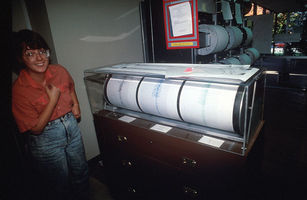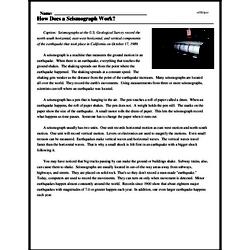How Does a Seismograph Work?
Caption: Seismographs at the U.S. Geological Survey record the north-south horizontal, east-west horizontal, and vertical components of the earthquake that took place in California on October 17, 1989.
A seismograph is a machine that measures the ground motion in an earthquake. When there is an earthquake, everything that touches the ground shakes. The shaking spreads out from the point where the earthquake happened. The shaking spreads at a constant speed. The shaking gets weaker as the distance from the point of the earthquake increases. Many seismographs are located all over the world. They record the earth's movements. Using measurements from three or more seismographs, scientists can tell where an earthquake was located.
A seismograph has a pen that is hanging in the air. The pen touches a roll of paper called a drum. When an earthquake happens, the roll of paper shakes. The pen does not. A weight holds the pen still. The marks on the paper show the size of the earthquake. A small motor rolls the drum of paper. This lets the seismograph record what happens as time passes. Someone has to change the paper when it runs out.




